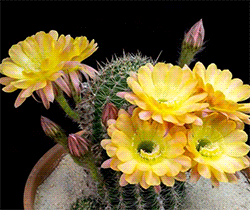Flower gardening ‖ The most complete collection of tips on how to kill pests and diseases in housegrown flowers
There are many kinds of flowers at home. Flower growers focus on watering and fertilizing, but often ignore the prevention and control of pests and diseases, which affects the healthy growth of flowers and hinders their appreciation. The prevention and control of pests and diseases of domestic flowers requires environmental protection, and chemical prevention methods should be avoided as much as possible. Therefore, the garden guard consulted a lot of information and collected and sorted out some clever ways to prevent and control pests and diseases of domestic flowers for your reference.

When growing flowers at home, some diseases and insect pests often occur, which affect the healthy growth of flowers and thus their ornamental value. Because the number of domestic flowers is small, and the prevention and control of domestic flower diseases and insect pests requires environmental protection, chemical control methods are avoided as much as possible. The measures for preventing and controlling domestic flower diseases and insect pests are introduced as follows:
First, place the flowers according to their growth characteristics, such as light-loving, shade-tolerant, moisture-loving, or drought-tolerant. Place light-loving flowers in a sunny place as much as possible; place shade-tolerant flowers under light-loving flowers or in a place where the sun cannot directly shine; the interval between watering for moisture-loving flowers should be short; the interval between watering for drought-tolerant flowers should be long.
Secondly, watering should be done when the soil is dry and when it is wet. That is, when you find that the soil in the flowerpot is about to dry out, water it thoroughly at once. Do not water halfway, that is, the soil in the flowerpot is wet on the top and dry on the bottom. The easiest way to check whether the soil in the flowerpot is dry is to flick the middle of the flowerpot wall with your finger. If you hear a relatively crisp sound, you can judge that the soil lacks water. At the same time, during the growing season, apply some compound fertilizer or water with soaked sesame fertilizer water. Prune in time to remove diseased and insect-infested branches, overlapping branches, weak branches and overcrowded branches.

Manual removal: When scale insects are found on flowers, they can be removed with bamboo sticks or brushes; if there are leaf-feeding pests on the leaves, they can be pinched to death with tweezers; if there are whiteflies or aphids, they can be gently brushed off with a brush; when insect holes are found on the main trunk or branches of flowers, wire can be inserted into the holes to pierce the pests to death or the tip of the wire can be bent into a hook shape to hook out the insect body.
Color insect repellent: laying a silver-gray mulch under the flower pot or hanging a silver-gray plastic tape on the upper part of the plant can repel migratory winged aphids. You can also hang yellow boards above the flowers and apply motor oil or vaseline on the yellow boards to attract and stick to female aphids, reduce their occurrence and prevent the spread of viruses.
Using watermelon rind to control insects: Putting watermelon rind on the soil in the pot can help you not to water for 4 days, and it can become a good nutrient for potted flowers. If you put a few cigarette butts in the watermelon rind, the tobacco juice can seep into the saline soil and kill most small insects.
To water bitter melon leaf juice, take the tip of the bitter melon leaf, add clean water, mash it to extract the original liquid, add an equal amount of lime water, stir evenly, and water the roots of the plant seedlings to prevent and control cutworms.
Spray citrus liquid. Soak citrus seeds in clean water at a ratio of 1:5 for 4-5 days, then soak the flower seedlings to be sown or planted for 5-10 minutes to prevent and control a variety of flower pests. Soak citrus peels in 10 times the amount of water for 24 hours, filter and spray, to prevent and control aphids, red spiders, leaf miners, and watering flowers to prevent and control soil nematodes.
Spray Ginkgo Biloba Liquid: Put the fruit into a mortar and mash it, add an equal amount of water, and filter to get the original liquid. When using, take the original liquid and dilute it with water at a volume ratio of 1:2 and spray it to prevent and control aphids.
Spray the arborvitae liquid , wash and mash the arborvitae fruits, add water at a weight ratio of 1:5 and soak for 24 hours. Take the filtrate and spray it directly to prevent and control leafhoppers.
Spray peach leaf liquid Take peach leaves and add water in a weight ratio of 1:6, boil for 30 minutes, take the filtrate and spray it directly to prevent aphids and other mollusks
Spray tung oil liquid , chop the old leaves, add water at a weight ratio of 1:3-1:5; or use the peel, add water at a weight ratio of 1:10, soak for 24 hours, the filtrate can prevent and control aphids.
Spray the plants with whitehead liquid , wash, chop and mash them, add water at a weight ratio of 1:10, soak for 23 hours, or boil for half an hour. The filtrate can prevent and control aphids, leafhoppers and lace bugs.
Wash, chop and mash the stems with spray flower liquid , add water at a weight ratio of 1:5, soak for 24 hours. The filtrate can prevent and control aphids, leafhoppers and web bugs.
Spray the lacquer liquid , chop and mash the stems and leaves, add water at a weight ratio of 1:4, boil for 1 to 2 hours, and spray the filtrate to prevent and control aphids and red spiders.
Spray mint liquid , chop and mash the mint, add water at a weight ratio of 1:5, soak for 24 hours, and the filtrate can prevent and control leafhoppers and lace bugs.
Castor bean pest control: Dry the leaves and stems of castor bean, grind them into powder, and apply them to flower pots to prevent pests.
To control insects, wash and mash the maple poplar branches and leaves, and bury them in the soil to prevent cutworms and mole crickets.
Walnut branches, leaves and peels for insect control: Wash one or more of the walnut branches, leaves, peels, etc., mash them, add 15 times the amount of water and soak them for 24 hours. Spray them on the branches and leaves of potted flowers to prevent aphids, wireworms, etc.
To spray tobacco liquid , use 40 grams of tobacco powder, soak it in 1000 grams of clean water for 24 hours and filter it. When using, add 1000 grams of clean water and spray it on the pot soil and around the bottom of the pot to prevent and control nematodes. If 2% soapy water is added to the solution to increase the adhesion, after spraying, it can also treat aphids, red spiders, ants, etc., or take 10 grams of tobacco leaves, 10 grams of plant ash, 1000 ml of water, mix them into a glass bottle, stir them well, soak them for 24 hours, filter them, and add a small amount of laundry detergent to spray them for better results.
Spray onion liquid: Take 20 grams of onion scales and soak them in 1000 ml of water for 24 hours. Spray the flowers with the soaking liquid once every 24 hours. Do this three times in a row to prevent and control aphids, red spiders, etc.
Spraying garlic liquid Take 20-30 grams of garlic, mash it into garlic liquid, filter it, add 500 grams of water to make a liquid spray, once a day, spray 3-4 times in a row, it can prevent and control powdery mildew and black-brown disease of Rosaceae flowers, and can also kill soft-bodied pests and insects, with an efficiency of 100%. Watering the potting soil can prevent and control aphids, red spiders, scale insects, etc. You can also smash the garlic cloves and put them in the potting soil. With normal maintenance, earthworms, ants, and nematodes will disappear within two or three days.
For the chili liquid spray, you can use fresh chili or dried red chili, or take about 25 grams of the seeds discarded from fresh chili, crush them and add 10 times of water to spray, or mix half of the dried seeds with lime powder and roll them into fine powder for spraying, or use 50 grams of chili and add 30-50 times of water, boil for 30 minutes, filter and spray. You can also take oleander branches and leaves and chili, chop them, put them in a pot, add 20 times of water and boil for 20 minutes, filter and spray the liquid after cooling. Under normal circumstances, a pot of flowers can be sprayed or sprayed with about 100 grams of powder, which can prevent and control pests such as aphids, silkworms, red spiders, and Ailanthus altissima.
Spray pepper liquid: take 20 grams of pepper and add 250-300 grams of water, boil for 1-2 minutes, and spray on the flowers after cooling.
Plant insecticides include planting onions, garlic, leeks, etc. in the potting soil under flower plants. They release volatile substances that not only have the effect of repelling and killing aphids, but also have the effect of curing diseases.
Spraying detergent liquid : Use 3-4 grams of detergent, add 1000 grams of water to make a solution, spray 2-3 times in a row, and the control rate of aphids reaches 100%. It is also very effective for scale insects, white butterflies, green caterpillars, etc. If 2-3 grams of urea is added to every 1000 grams of detergent solution for spraying, it also has the function of foliar fertilization. Or use a solution of cigarette butts, orange peels, ginger, garlic, etc., add a little detergent to remove insects, which can further improve the effect and range of insect removal. Or use neutral detergent, diesel, and water in a ratio of 0.6:10:6 to make a mother liquor. At this time, the mother liquor contains 60% oil and is milky. Dilute it into a liquid containing 3% oil when using it, and spray it. It can kill scale insects in one week.
Detergent kills whiteflies . Whiteflies not only suck the juice of leaves, but also secrete mucus to make leaves wither. You can mix 1 spoon of detergent with 4 liters of water and spray it on the leaves every 5-7 days until the whiteflies are completely killed.
Camphor balls for insecticide : Grind the camphor balls and spread them into the soil to kill the pests that damage the roots in the soil. It is especially effective against root nematodes of tubers, bulbs and fleshy root flowers such as peony, dahlia, lily and amaryllis.
To kill insects , spray 500 times diluted detergent, which can kill pests within 24 hours. Then spray clean water to reduce the side effects of detergent.
Milk Kills Insects: Ticks often attach to the stems and leaves of flowers, which can cause the leaves to change color and wither. You can use half a cup of fresh milk, 4 cups of flour, and 20 liters of water to mix, then filter with gauze and spray the liquid on the branches and leaves of the flowers. It can not only kill ticks, but also kill insect eggs.
Flour to treat insects. When potted flowers are infested with diseases and insect pests, take a small amount of flour, mix it into a paste with cold water, then use an appropriate amount of boiling water to make a 1:50 solution. Spray it on a sunny day, and it will have a good preventive effect.
Pour some beer into a shallow basin to drown insects , and then place the basin at the bottom of the pot. Some pests, such as snails, will automatically follow the smell of beer and enter the basin, and then drown.
Apply vinegar: Soak a cotton ball in 50 ml of vinegar. Use tweezers to gently rub the soaked cotton ball on the affected stems and leaves of flowers and trees. This will kill the scale insects and make the leaves shiny and green again.
Spraying vinegar with 300 times vinegar solution on flowers can cure black spot, brown spot, powdery mildew, downy mildew, and chlorosis caused by iron deficiency or soil alkalinization. Spray once every 7 days, and spray 3-4 times in a row to cure it. You can also wipe it with a cotton ball dipped in vinegar, which can kill pests and make the diseased leaves turn green again.
Mosquito-repellent fumigation: Hang a plate of mosquito-repellent incense on the branches of flowers and light it, cover the flowers with plastic cloth, and the pests can be killed in 12 hours. But the time cannot be too long, otherwise it will affect the growth of flowers.
Watering with liquor: Dilute 60% liquor with water in a ratio of 1:20, and use the mixture to water the flowers. The best time is early April, watering once every 10 days for 4-5 times in a row. It can effectively prevent and control scale insects.
Spraying Fengyou essence Use Fengyou essence and water in a ratio of 1:400 to make a solution and spray it on flowers. This method has the best control effect on scale insects. If you want to control aphids and red spiders, you can spray more on the insect body.
Inject pure alcohol: Inject pure alcohol into the holes bored by trunk-boring pests, allowing the pure alcohol to penetrate into the branches and trunks, killing the pests.
Vaseline is used to prevent and control wood-boring pests. Applying vaseline to plug the holes will cause air to become blocked, which will lead to suffocation and death of the pests.
Take 50 grams of wood ash, add 2500 grams of water and stir thoroughly. Soak for 48 hours and then filter. Then add 3 grams of laundry detergent and spray once a day for 3 consecutive days. After 7 days, spray for 3 consecutive days again. This can eliminate the second generation of pests, such as aphids, red spiders, whiteflies, scale insects, leaf-eating insects, etc. It can also be applied to the soil to prevent and control maggots.
For pest control , spray 2% urea, 1% ammonium bicarbonate or 0.5% ammonia water to fumigate and kill aphids and mites. Or spray a mixture of 0.5%-1% urea and 0.2% laundry detergent to prevent red spider mites and aphids. Or apply 4.5-6 grams of calcium silicate fertilizer for every 0.1 square meter of flower pot area. After the flowers absorb it, it accumulates in the epidermal cells, making the epidermis hard, which can enhance the insect resistance and make it difficult for aphids and other piercing-sucking pests to harm them.

Potassium Permanganate can be used to control powdery mildew. Spray the flowers with 0.02-0.03% potassium permanganate solution. After a few days, the spots will gradually disappear and the diseased leaves will resume normal growth.
Use vinegar to prevent and control powdery mildew. Add vinegar to water to make a 5% solution and spray it. After 2-3 times, it can prevent and control powdery mildew.
Baking soda water for preventing and controlling powdery mildew. Baking soda solution is weakly acidic, and pathogens can hardly survive in a weakly acidic environment. Therefore, spraying flowers with 0.2% baking soda solution is effective in preventing and controlling powdery mildew.
Garlic juice can prevent and treat rot. Use a knife to scrape off the rotten parts of the flowers to expose the healthy tissue around the diseased part. Then, apply garlic juice evenly on the wound. Apply it once a week and it will be cured after 2-3 times.
To prevent and control rot with iodine, scrape off all rotten parts of the flowers, deep into the wood, apply iodine, and apply again after 7 to 10 days to completely cure.
Use wood ash to prevent and control root rot . Remove the surface soil of the flowerpot to expose the roots, cover the roots with an appropriate amount of wood ash (depending on the size of the flowerpot), and then cover the wood ash with soil. This is very effective in preventing and controlling root rot, especially for daffodils and cacti.
Masson pine needle liquid for preventing and controlling root rot. Take pine needles at a weight ratio of 1:2-3; add water and boil for 2 hours to make it slightly gelatinous; take the filtrate and dilute it with water at a volume ratio of 1:1 to prevent and control root rot.
To prevent and control root rot of hibiscus, add water in a weight ratio of 1:10 to hibiscus and soak it for 24 hours. The filtrate can prevent and control root rot and damping-off disease.
Ginger juice can be used to prevent and treat rot. Take the ginger, mash it and squeeze out the juice. Then take the juice and dilute it with water at a volume ratio of 1:20 and spray it to prevent and treat rot.
To prevent and control rust of chives , take chives and mash them. Add water in a weight ratio of 1.6:10, then stir well and spray the filtrate to prevent and control rust.
To prevent and control powdery mildew with green onions , take green onions and mash them. Add water in a weight ratio of 2:1.5, filter and spray. This can prevent and control powdery mildew.
To prevent and control garlic diseases , mash the garlic, add water in a 1:1 weight ratio, stir well and take the juice. Dilute the juice with water in a 1:3 volume ratio and spray it to prevent and control powdery mildew, gray mold and root rot.